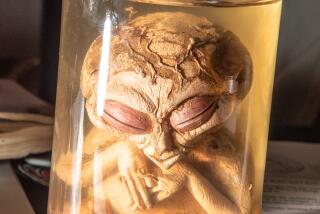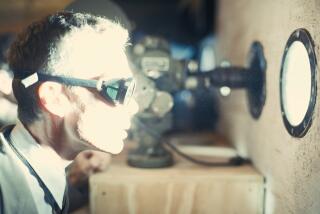A Cold Shoulder to Science : BAD SCIENCE: The Short Life and Weird Times of Cold Fusion, <i> By Gary Taubes Random House; $25; 503 pp.)</i>
“Bad Science” is right. Bad journalism, too.
For many scientists and non-scientists alike, the short, silly history of cold fusion began with a dramatic headline on Page 1 of the Wall Street Journal in March, 1989: “Taming H-Bombs? Two Scientists Claim Breakthrough in Quest for Fusion Energy. If Verified, Utah Experiment Promises to Point the Way to a Vast Source of Power.” (The Los Angeles Times, too, presented the Utah claim on the front page; the New York Times and the Washington Post displayed more discretion.)
Taming H-bombs indeed. Fusion is the nuclear process that powers the sun, sustainable only at temperatures measured in the millions of degrees. Nuclear physicists have pursued fusion-generated electricity as a quixotic dream for nearly a half-century in giant international laboratories at a cost of billions of dollars--$8 billion in the United States alone. Despite these vast expenditures, practical nuclear fusion has always remained somewhere just over the horizon. Super-hot fusion reactions can be set off for short instants, but the state of the art is such that they tend to use more power than they generate, by a considerable margin.
So a healthy bit of skepticism might have seemed appropriate when a pair of chemists claimed to have sidestepped conventional physics and created a hitherto unknown form of nuclear fusion--”cold,” room-temperature fusion--in a glass beaker at the University of Utah. They used, as the Wall Street Journal said, “no more equipment than might be used in a freshman chemistry class.”
Skepticism was in short supply in Utah. On the contrary: A university official told reporters that cold fusion “ranks right up there with fire, with cultivation of plants and with electricity.” Hundreds of scientists began a fevered scramble to recreate the results--some in a responsible and pragmatic spirit, but many others in a search for glory that led to pregnant-sounding reports of “Results Hard to Explain in Conventional Terms.”
These were the essential meat of a long series of articles in the Wall Street Journal and elsewhere: Scientists did not quite understand what was happening in their jury-rigged beakers, so reporters used words such as inexplicable and mysterious and fascinating. In a patriotic spirit, the Utah state legislature rushed to appropriate millions of dollars for more research (and more patent lawyers).
As a social phenomenon--a “collective derangement of minds,” in Gary Taubes’ apt phrase--cold fusion sputters on to this day. A few hopeful fringe researchers continue to produce mysterious sounding and non-reproducible results. The current issue of “Popular Science” features on its cover an all-too-familiar example of the “If True” style of journalism typical of the affair, by the same Wall Street Journal reporter whose rose-colored coverage played such a central role in cold fusion’s start. “Fact or Fantasy: Cheap, Abundant, Non-Polluting Energy Source? Or Pseudoscience?” It may as well be the National Enquirer on abductions by aliens. “The Debate Refuses to Die.”
In “Bad Science,” Taubes has written a detailed, wry and definitive history of one of our century’s grandest scientific hoaxes--perhaps the grandest since the discovery of the mythical “Piltdown Man” in 1912. For a hoax is what cold fusion was. Taubes documents that beyond reasonable doubt: the scandalously incomplete experiments, the tactical evasions by researchers confronted with legitimate questions, the suspiciously, impossibly clean data diagrams.
Taubes avoids the word, however, just as he is careful with what one university official calls the “F-word”: fraud. The Utah chemists, Stan Pons and Martin Fleischmann, refused to respond to Taubes’ questions and their psychology remains a mystery. It is hard to imagine that they deliberately set out to deceive the scientific community. (Both men have left the United States; Pons reportedly continues to pursue cold fusion on the French Riviera with the help of a Japanese corporate sponsor.)
That they did deceive and mislead seems undeniable. Taubes in the end sides with a chemist who says the scientists’ behavior was not rational enough to be fraud: “They were caught up in it and they just couldn’t analyze what was going on.”
The entire corpus of scientific knowledge produced by the cold fusion affair can be summed up in a few words: “If you put electrodes of exotic metals like palladium and platinum in a jar, pour in water laced with such other substances as lithium, and run a strong electric current through, complicated chemical reactions can occur. The water molecules’ hydrogen and oxygen atoms can be pulled apart and can recombine, even explosively. If you are careless, the bookkeeping of energy flowing into and out of the jar can be hard to manage accurately.”
In Taubes’ exhaustive chronology of both the experiments and the news coverage, he makes it easy to see, finally, what went wrong with both. Some of the bad science was almost comical. At one point, experimenters who seemed to be measuring mysterious excess heat from some newly discovered reaction decided to turn off an automatic electrical stirrer and unplug an electronic thermometer; sure enough, the excess heat dropped to zero.
Another much sought (and never seen) sign of cold fusion would have been the radioactive emission of neutrons; one scientist who was inexperienced with delicate, finicky neutron counters finally discovered that he could set off the devices merely by lacing a beaker of warm water nearby--they were heat-sensitive.
Taubes also documents the spread of contagious self-delusion that characterized the whole episode. There was an absurd competition between two groups, both in Utah, for priority and patents. The experiments may have been at the Keystone Kops level, but that did not stop the researchers from bringing in the patent lawyers and notarizing their lab books.
The competitors fed off each other emotionally as well as scientifically: If the experiment isn’t any good, why is that other guy trying so hard to steal it? Or, as the president of the University of Utah put it: “She must be a good-looking girl if somebody else wants to date her.”
The Utah Attorney General hired a team of outside trial lawyers “to protect cold fusion for the state.” The Salt Lake Tribune and the Deseret News were also solidly aboard the bandwagon--as Taubes says, “approaching the story as though it were a political election or a sporting event” and rooting for the home team. The Deseret News created a running logo: “Utah’s Fusion Future.”
Almost as boosterish was the Wall Street Journal--perhaps, Taubes suggests, because the paper had been embarrassed by its poor performance two years earlier on a superficially similar episode involving real science, high-temperature superconductivity. For whatever reason, the paper had no patience with “skeptics.” It editorialized weeks after the first announcements: “The world does not yet know conclusively whether Stanley Pons and Martin Fleischmann will enter science’s pantheon with Ernest Rutherford, one of the giants of 20th-Century physics.” It attributed the skepticism of respectable physicists to “the compulsive naysaying of the national mood,” and declared, “Clearly, scientists have once again discovered something new under the sun.” As Taubes says, the Journal had become “a participant in the blossoming science and not just a reporter of the facts.”
It is a fact of life about science reporting that the raw material tends to be too esoteric for the reporter to comprehend--the journal articles, the laboratory notes, even a good part of what comes out of a scientist’s mouth during an interview. Journalistic success or failure depends more than anything else on how well a reporter learns to cope with this one fact.
One good rule is to scrutinize your own motives. Are you unnaturally eager to have a Page 1 byline today? Another is not to be scared away from using your own judgment--don’t abdicate responsibility to the experts. Just because the jargon is incomprehensible doesn’t mean that the basic facts are.
Remember that quotations to the effect that “if it’s true, it’s terribly important” are utterly worthless. As Taubes points out, “This is what scientists invariably tell reporters when referring to seemingly bizarre discoveries of which they have no knowledge.” Scientists tend to be publicly polite to their colleagues.
Journalists and scientists alike are capable of becoming alert to the danger signs in questionable research. Watch out for when challenges are evaded with ad hoc exceptions. Does a reaction fail to produce the neutrons associated with ordinary fusion? Pons could simply say, “There’s no reason the reaction has to be the same.” Palladium seems not to work for other people? The metal has to be “fusion grade.” As Taubes says, “It could begin to sound suspiciously like magic. . . . A belief in cold fusion required an act of faith from the start.”
In the end, of course, good science and good journalism did prevail. Scientists used their usual experimental and institutional tools and their normal professional skepticism to sort out the fact and fantasy, and reporters who had resisted the initial temptation to sensationalize were more than repaid for the Page 1 stories they sacrificed.
Still, the damage to the public’s confidence in real science and science reporting, filled as they are already with magical-sounding phenomena, was genuine and perhaps long-lasting. If there is one ultimate lesson in the affair, for journalists as well as scientists--one rule to remember when all else blurs in confusion--it must be Feynman’s Law, quoted by Taubes as an epigraph.
“The first principle,” the physicist Richard Feynman once said, “is that you must not fool yourself, and you’re the easiest person to fool.”






